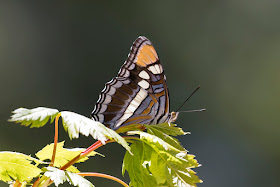Our group may yet grow back to its old strength in numbers! And haven't we all grown in skills, knowledge, camera size, social media connectedness .. to mention only a few growth aspects.
Bill George (second from right) summed up some history that I had forgotten: The Gallery Gang, goes back a few years (just about a decade or so) to when our local newspaper, the Arizona Daily Star, had a Reader's Gallery where we could send in photos hoping to have them published in the newspaper. The Gallery Gang were all those selected by the newspaper as "Gallery All Stars"
Each of us had a full page spread of our photos along with an interview and a bio. We came together after that and did some photo shoots, but as things happen in life we drifted apart - to finally reunite now.
For myself I should add that this interactive Star Gallery was the first step towards social media, including BugGuide and my blog.
 |
| Rose-breasted Grosbeak by Doris Evans |
Most birds, though, seemed to be on their home turf by now and busy building nests. We had been tipped off that there would be a Buff-breasted Flycatcher at Rose Canyon, but we found instead a Cordilleran Flycatcher moving into one of the one ugly, out-of place structure, a huge container trailer that for some obscure reason was parked down there. Actually, Robert Bateman would probably see a beautiful painting in the contrast between the dainty, fluffy bird and the texture of the rusty convoluted entrails of the trailer.
 |
| Bill George says that birds aren't quite his 'thing in photography, but his group photo certainly speaks for his skills |
Bird photography isn't quite my thing either, and I'm blaming my tools (of course). And the branches, and the dappled light ... and this pose: who can tell that this absolutely devoted singer is a Yellow-eyed Junco? But just click on the link!
Incinerator ridge (views of old mining sites from higher up may explain the name) yielded some elusive warblers, a number of Spotted Towhees and several pairs of Western Tanagers. Doris told me a trick to remember the name: the males sport the colors of a western sunset. Our target birds showed up, too, but later better and more.
 |
| Squirrel, Abert's or Arizona Grey? Cliff Chipmunk, Black-headed Grosbeak and Yellow-eyed Junco |
 |
| Red-faced Warbler by Lois Manowitz |
The mournful flute song of Hermit Thrushes rung through the Ponderosa Pines and House Wrens interrupted their constant hunt for insects to belt out their sharp little songs.
A pair of Painted Redstarts chose a nesting site that did NOT meet with the groups approval. So exposed! So close to the road!
But the critters up here were in general not shy of humans. A Pocket Gopher peaked at us from his hole, then very decisively slammed it shut with some soil. But reemerged immediately closer to us. Disappeared again and popped up literally between my feet, where he became the center of attention and stayed.
I held out a stick and he grabbed it, got it stuck across his burrow entrance, corrected quickly and pulled it in. Checked whether it fir the subterranean design, found it wanting and tossed it out of yet another hole. The area was a veritable Swiss cheese. The gopher became our star entertainer of the afternoon.
 |
| He smiles at his easily amused fans |
I was of course also looking for insects. Like on my recent Sonora trip, Veined Ctenucha Moths were flying in numbers. House Wrens demonstrated that that their vivid coloration does not necessarily scare predators from eating them.
 |
| Arizona Sister by Ned Harris |
 |
| Left top and bottom Andrena milwaukeensis (Milwaukee Andrena), top right Megachile Subgenus Megachiloides or Xanthosarus, and buprestid beetle Anthaxia Subgenus Melanthaxia |
 |
| Stiletto Fly (house fly sized) and Bot Fly (monster sized) |
In the afternoon Collins Cochran and spouse and Doris Evans and I took the service road to Oracle down the back side of the mountain.One of the reasons to get my new Subaru Forester was that I wanted to be able to do that. Landscape-wise the trip was worth it - beautiful vistas.
But it was so dry that we found few reasons to stop - no freshly green bushes to beat, no flowers to glean for insects - or maybe I was just to tired. Doris was revived by a Red Tail Hawk on the wires above, I stopped for a folk art piece or rather weird cultural statement and the towering flower stalks of yellow blooming agaves.













Oh, Margarethe, this is wonderful. What a nice narrative on our day in the mountains - the story of "Our Gang" and all the adventures of that memorable day.
ReplyDelete